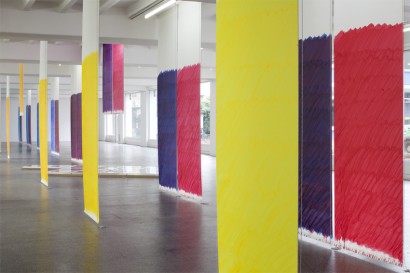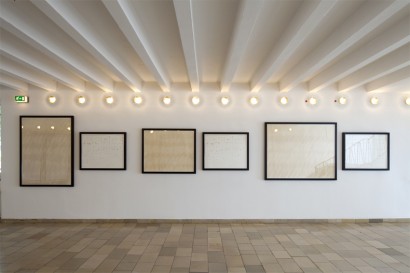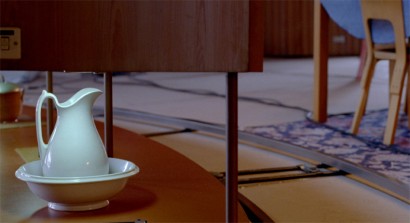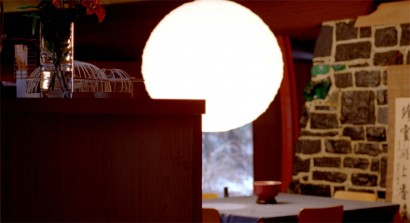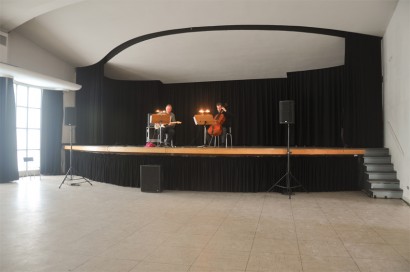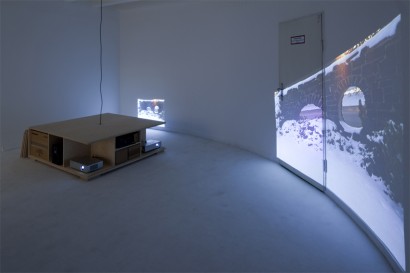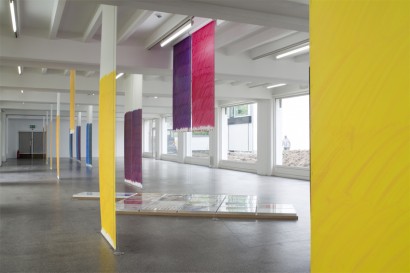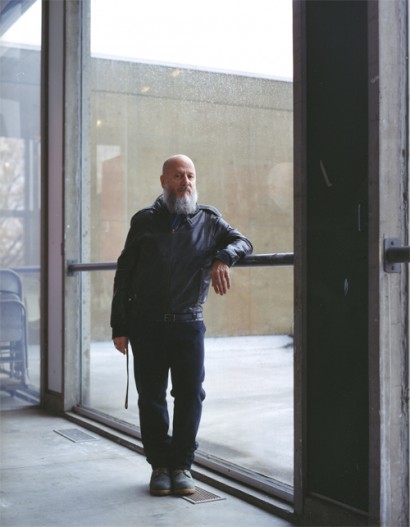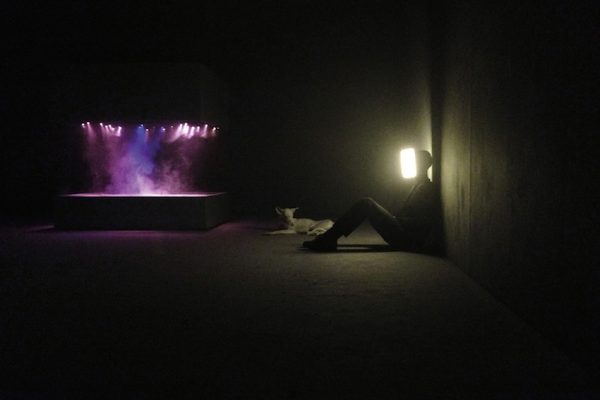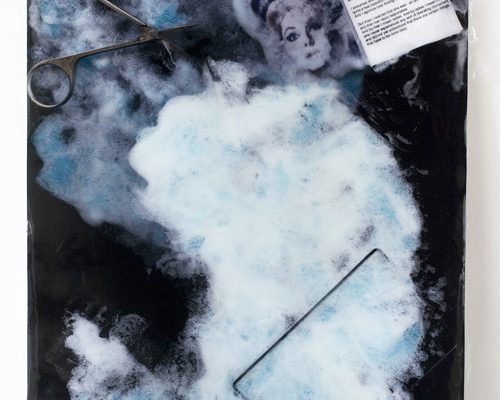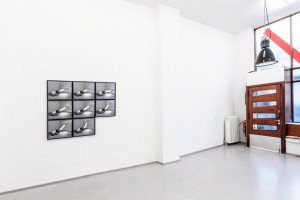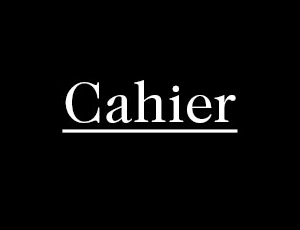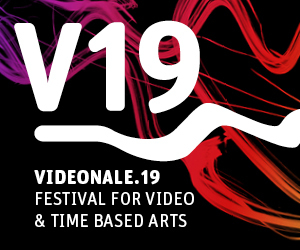
That’s the one, man!
/ EN /
An interview with Stephen Prina about his current show at Kölnischer Kunstverein, (June 11 – July 24)
In your work you are concerned with the formal process of exhibiting: choosing and labelling work, mainly key works of modernism, but also in archiving them. Do you see yourself as a curator, in the sense of that you care for these works?
Yes, very much. Earlier on my work was described as being involved with institutional critique, so using the structure of cultural institutions and their administrative aspects as being the material of an artwork. I had made a project in 1991 at the Gallery Max Hetzler where I used the archive of that gallery when it was in Cologne as the material for a project. And at that point the gallery had been open for 17 years and so I was presenting a visual history of the gallery but only limited to what was in the archive. Using installation shots of every show that Max had staged and when there wasn’t an installation photo of an exhibition I had a photograph of a photographers grey card to take the place, so it reads as a monochrome image. So for instance Max had done a show with Gerhard Richter and instead of making installation shots of the show there were very fine chromes of each painting. So it was thought that it was not important to do an installation shot. And so this was in the 80s and this was when Richter was making the very colorful abstract paintings but to substitute a photographers grey card for one of those makes one think of earlier works that Richter had made, the grey monochromes, and to use one of those photographs as a label of Gerhard Richter but with a later day it makes one think what was the work that was being exhibited. And if I remember correctly Martin Kippenberger acquired that photograph because he really got the spin that that image generated.
»Exquisite corpse« is an ongoing work in which you catalogue the oeuvre of Edouard Manet through monochrome paintings in the exact scale of the original painting. Which works did you choose for Cologne and why did you decide for those ones?
Number 227 of 556, 228 of 556 and 229 of 556 and this is the most recent one I have made. And I can’t do any more in Los Angeles now because I don’t have any more paper. This was the end of the roll. You can even see it in this one. It was not visible when I made the drawing and as soon as I put ink on it popped up, an indentation that was left by a piece of tape that adhered the role of paper to a large cardboard roll. And when I saw that I thought: Oh my god what happened? But then I said: No, no, no, no, I accept that, I leave that in, so that makes this drawing slightly more distinctive than the rest. But the drawings are always unique anyways and they always have a distinctive quality. So these are the works, the model paintings from Manet’s oeuvre: Baigneuses en Seine (Bathers in the Seine) from 1874 but with a question mark because the don’t really have the final date for that work and it’s in the Museu de Arte in São Paulo and I made this drawing on March 7, 2011 and then I went out of town and made the next one on March 26 and this is Claude Monet et sa femme dans son studio flottant (Claude Monet and His Wife in His Floating Studio) from 1874 and that’s at the Neue Pinakothek in Munich and the next one is again Claude Monet et sa femme dans son studio flottant from the Hammer Gallery New York from March 26. All of this information comes from a 1969 publication, it’s a penguin paperback of the catalogue raisonné of Manet and it brings together several different findings by authorities but it is not the final catalogue raisonné and so I always replicate the information in that. This work for instance is no longer in the Hammer Museum of New York it is now in the collection of the Museum of Modern Art in Stuttgart.
And so it’s the logic of the numbers that you are following here?
Yes, and I make all of them in sequence. These four (pointing at the numbers 223-226) are currently on view at the Secession in Vienna and this was shown in Berlin for an exhibition I made there in March at Capitain Petzel. But I made some of them and put them in my studio because I decided I wanted to focus upon this sequence because they make little essays of sorts. So for instance the ones in Vienna all of them have to do with boating and water. And with the ones here, a lot of people write about this work as the complete paintings of Monet and to have this kind of double Manet Monet reference I thought that was just too good to leave. And these are little things that only someone who is a connoisseur will understand. These two works here have the same title but that’s the more finished painting (pointing at the smaller one) and this one is left very brushy and sketchy (pointing at the larger one). I often refer to this series as the spine of my work, I have been working on it since January 1,1988. So it’s the element of continuity that in some way brings together all these distorted projects that I do. I was very concerned even early on that my work would be seen as the work of a dilettante and I did not want to simply embrace discontinuity I wanted that discontinuity would play across the field of continuity of discontinuity and I think that this part of my work provides that.
How does that series differ from the works with the cord?
Do you know how these came about? Because I only started with them in 2008 and I was preparing an exhibition, kind of a survey exhibition at the Kunsthalle Baden-Baden and I have been working on that for a year. There are nine rooms all of different proportions and ceiling heights, some of them quite intimate, some of them are quite vast. So I had a sequence figured out and I was showing 133, 134 and 135. 135 is the largest work that Manet ever made and it’s the Execution of the Emperor Maximilian. So this is a little study for it, this was a large version that he rejected and cut up and after his death (pointing at the numbers 133, 134). Degas acquired those at auctions and glued them to a big canvas and so this is the final painting. So, two weeks before I was leaving for the installation I got a call from Baden-Baden from an assistant saying: „I hate to inform you but the door to the gallery where you want to show this is too small and we can’t move it in.“ And I could almost hear her take the receiver away from her ear because she thought I started screaming or something. I just started laughing actually because I considered that a gift. So I thought: How am I going to deal with this? And I immediately said: Well we make a placeholder for it. And I had not developed it until that point but I did not want to disrupt the sequence that I had designed for Baden-Baden. So these three works were exhibited in one room together but we couldn’t get that through the door so we took the dimensions not of the drawing but of the frame and made this black cord with brass nails that would hold its place along with its index. And it had the label for this work. And then outside of the room was the largest room in the space and I had originally planned to have a sequence of 35 small objects all the way around the room that then was divided by a wall that I built that you could see through. There were windows in the wall. So we just condensed the space between the elements of the 35 and made space for this large object with its index. It interrupts the flow of another work but it does not have a label so it’s this unidentified flying object that had come in. And just to acknowledge the economic dimension of what we do: There was a collector at the opening and he looked at the work in the room and asked me if it was a work, which of course means: “Is it for sale?” And I had never even thought of that because at that point it was a way of dealing with a situation at hand and I did not even answer his question and I said “Oh you have to talk with my gallerist.” But then I thought, ok these are works, I made them. And so now I often make these for exhibitions but they follow a different logic because here (pointing at the paintings) I am adamant about only making them in the order and some people said “Would you make that one for me” and I said “When the time comes.” I even said “I will safe it for you.” So these (pointing at the “Untitled” series) I do not make in order and I believe that at the gallery right now in the back room they have put one up where I have not made the drawing yet and that’s perfectly fine.
The aspect of completeness is very prominent in your work but at the same time there are often mainly elements of a larger series that you show depending on the context.
I often refer to that as a relay race. Where you have, let’s say two runners and one person has a batton and at one point there is a trade off and then it goes from one runner to another to another. Often I’ll isolate one element in one work and extract it and basically transpose it to another kind of context. And then maybe something from that transposition there will also be an element isolated and then it will become something else. But several stages down the line it is very difficult to make the connection between this layer stage and the so-called originary stage. I am interested in that kind of movement of translation because I think it is not the case that you retain all the elements of every configuration, in a certain context highlight elements and inhibit elements and then when it goes to another stage there is yet again a re-inscription or a re-prioritization of the elements on display.
In the 35 mm film we see the architecture of Bruce Goff (Ford House, Aurora, Illinois) and we hear a concert that takes place in the building. It’s a composition by Goff. How is the sound installation in the theatre space related to the film?
The music installation is again focusing upon elements, there are five movements in the film, the first movement is for solo piano, the second movement is for piano trio with cello and oboe and then in the third movement I join the trio and I sing with them a love song, or an unreplied love song, and then the fourth is a duet between marimba and vibraphone and the fifth is an instrumental tutti where all the instruments come together. The piano is playing a harmonic progression that proceeds in a circle of fifth and then there are always duets that play above that. There are fifteen duets that are based upon a melody that Bruce Goff had written. But in the film those duets take approximately 20 seconds to play and I have extracted those fifteen duets and I am using them for the live component of the music installation. But there has been a change in the description for the performance, so instead of taking 20 seconds to play those 20-second-duets take an hour to play. And they only play it once through and so there are very long sustained notes that disrupt the audio momentum and in the film there is this kind of compulsive momentum to those duets. But in the way they play life in the music installation they become notably static until there is an intervallic change that suggests cadential movement but that is how for so long the impulse towards that movement is static until the next interval changes.
The pre-recorded music was my attempt to deal with the live theatre space on a daily basis, with an installed work. And so this pre-recorded drone with the two musicians coming in once a day for an hour and playing. I would never present that as a concert though. It might be a huge failure but this was my attempt to say this is how I would place sound or music in that space and the pre-recorded drone itself is a sweep of a wide spectrum or the largest world spectrum that you can have because it goes from 30 hertz to 20.000 hertz and we can’t hear 30 hertz because it’s too low, it is subaudible, and we can’t hear 20.000 hertz because it is superaudible. And within that it is basically the chromatic scale of the piano from a very low pitch to a very high pitch. But instead of being that a subsequential scale all the notes sound simultaneously. And of course we are talking about western music here, it is every note of the western system so for instance every work by Mozart is in that drone, every work by Beethoven and every work by Schönberg. It’s accounted for. Except for Portamenti (laughing). So this is the Borges aspect of this project, kind of like the library of Babel where the library contains every book that is ever written and every book that will be written. And many of these volumes appear to be gibberish until we have the capacity to decode that. I also think that about that musical drone as being accountable to the monochrome painting. Of course there can’t be an exact analogy but the idea is like the one color that takes over a given amount of space wherever it be whether it be a stretched support or a wall or whatever in a way in which this drone accounts for every tone in the western system presented simultaneously.
I like how the projection in the basement is following the form of the staircase of the Kunstverein building. Do you see connection points between Goff’s architecture and this example of 50s architecture?
You know I have recently made a project that uses Rudolf Schindler architecture and when Philip Johnson made his very important international star architectural show at MoMa he did not include Schindler. And I think that this was a very huge oversight. But Schindler didn’t quite fit into the model of international star architecture. Neutra did but Schindler did not. And Bruce Goff most decidedly did not fit in to that model so at that moment he was really working against the tide of a rectilinear kind of architecture. Because from very early on in his work he embraced the circle as a form in his work and I think that that had a lot to do with the way in which he envisioned people moving through his spaces. So it is interesting to think that this 50s staircase which catapults you in a certain kind of spiral is then picked up somehow with the Bruce Goff in the basement. Especially if you use that video installation as a way to tie back to the film, which is all about circularity.
Often people have asked me about the film: What happens when the camera is hand held or when the camera is taken outside? And some people see that as the subjective camera with a subjective point of view and before that it was objective. And I don’t see it that way, there is always the subjective point of view whenever you are using a camera. But at that time we spent so much time in the circular house and what I am doing is reinforcing the circularity of it. Of course one could walk in a straight line in that house, one could walk in a 90 degree angle if you want and sometimes you need to use the staircase for instance but that is part of the conceit of the film that it becomes a circular world because the house is defined by this 240 degree arch. But I did not want to stay in this circular world and that’s why it was important to leave the house. And to suggest that there is something else out here. And you get little hints of that in the film with the narrow windows that are on either side of the door. Even when the camera passes by you see cars driving in a straight line so it’s kind of reminding you of the rigid grid outside but we are still in the circular world until we go out.
You can also hear a train outside.
Oh you heard that? Yes, that was very important to me. That’s a little bit of a personal thing because I grew up in Galesburg, Illinois which is a small town where all the major train lines are intersect in the country so during World War II, I think it was number three on the list to be bombed because it would just incapacitate the rail system if this would have been bombed. But I heard trains all day long and all night long but I never thought of it as being an irritant it was always a lullaby. It was very lucky for me that you hear that train sound. (Laughing) I thought that that was kind of like John Cage looking from heaven. And that was a shot we shot six times because that was the most difficult part of the music, for the marimba vibraphone duet. That’s also the one second soundtrack of the video installation when the vibraphone player says “That’s the one, man” it’s from that take. Like “Finally we got it”. And where that sound occurs in relationship to the film becomes the template for all the editing of the entire film. So I wanted to make sure I got that sound and so then every take is that long.
Life outside the gallery space also seems to be important for your work in the exhibition hall. You arranged the blinds very clearly towards the street. How does the social life out there interact with your work in here?
I was very pleased arriving this morning and seeing all the trucks working outside. I would like to claim that I arranged that but I have to confess that I did not and when I went down to take a photograph I asked the photographer if he could make sure that the green truck got into the shot with the red, yellow and blue. It reminded me of an anecdote that I think pertains here and it is something that the photographer said. He said something like: “Reality needs art.” and I said: “Well but I would like to think that my art is part of reality and not something that stands apart from it.” Years ago in 1990 I made a solo exhibition at P.S.1 in New York and I was showing a project called Monochrome painting and it is 14 panels of varying sizes, some of them very small, some of them very large. Like 2 by 3 meters but all of them were Belgian linen stretched over supports and then I put them through an auto body shop and they were sprayed with a color that Volkswagen used only in one year, in 1985, papyrus green, which was a metallic paint. This project was exhibited in three consecutive rooms and outside of that was a very large wall painting announcing it in graphics but there was a discussion with some of the curators, actually a curator, with whom I was not working but the curator was on the stuff and this curator insisted that the windows in the space be covered. They have frames that fit into the windows that have muslin over them and she was saying: „Well there are paintings in this room and they have to be protected from the light“, and I am thinking they are sprayed with auto lacquer so they are virtually indestructible. But this person was insisting and saying: “No, when we show art we have to cover the windows” and I thought, well what kind of argument can I propose that will allow the windows to be without being shrouded. And I said: “If you cover the window you won’t be able to see the gas station across the street and it is very important for me to see the gas station.” And I did not say anything else. I did not say how or why and I think it was enigmatic enough, they backed off and left the windows open. It’s because I don’t think of my art as standing apart from the general society I think of it as part of that. So I would like to think that it is more continuous with the gas station then not. And some people don’t have that opinion but I always thought that modernist painting occupies at least one if not many points of conversions across the social fields.
And here at the Kunstverein you constructed this architectural corridor that divides the space. So if you lifted one of the blinds the concept of the painting would be destroyed?
It would only be left as wastage in memory. Because after the show they will be dispersed and so the logic that is generated by the architecture in relationship to this limited palette will become very distant because you won’t see this in relationship to this or that you will be focusing upon those three. I always refer to them as blinds and not shades because I think of them as engaging in the mechanism of making certain things visible and certain things invisible because they always block the view of something else which I think every artwork does that. So that is part of what I am trying to do in my work is to locate a general tendency of art, an attempt to give form to it.
(Walking through the space) You now this is the way I make a diptych, the two panels come together, the hardware meeting makes the dimension of the gap but with the triptych the first two panels have to go together with this and then the third panel must be at least a meter away. So this could be in a different room and it would still be a triptych painting. Or this could be in a different building or this could be on the other side of the planet but it would still be one painting. So I was very interested in that idea of space and looking beyond it but then this is a different spatial characteristic that this painting can be on the other side of the globe and I would think that this is the biggest painting you could make. But just saying that, Pierro Manzoni is breathing down my neck, isn’t he? Manzoni made a shadowingly profound artwork it’s Le socle du monde (The pedestal of the world) a circular concrete public sculpture and it’s as though Manzoni has appropriated the entire earth in one gesture. And I always thought of that as a response to Duchamp. Duchamp could even though he maintained that he would not select every and any object in the world as a readymade. But with Manzoni he takes that logic and accelerates it. So once Manzoni has appropriated the world what’s left to do? And so these are my entities into that question.
Thank you very much for this interview!

